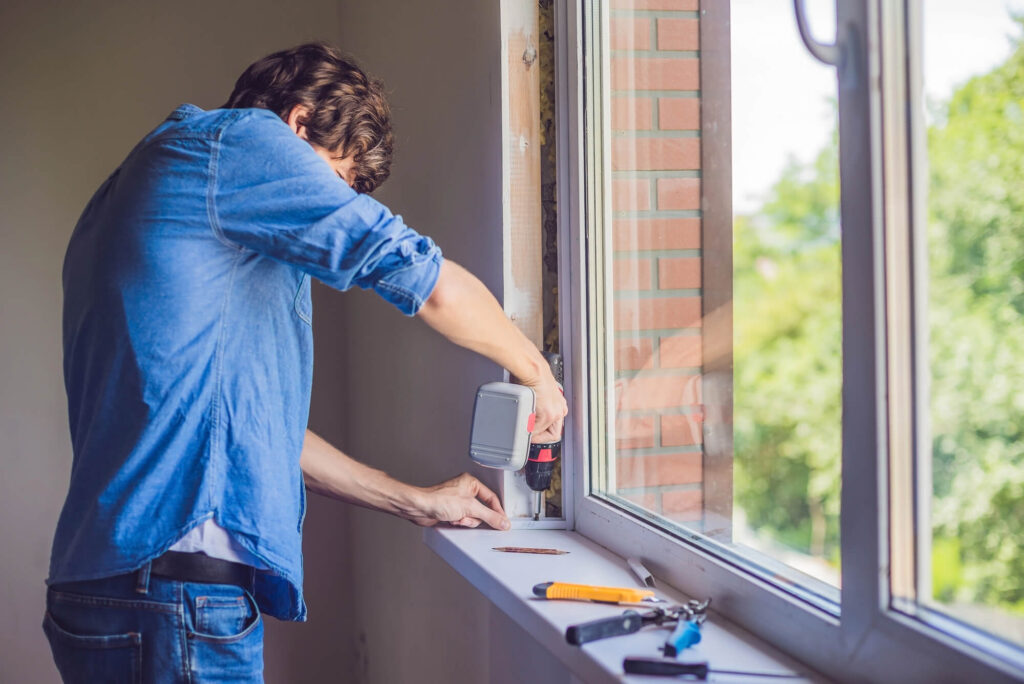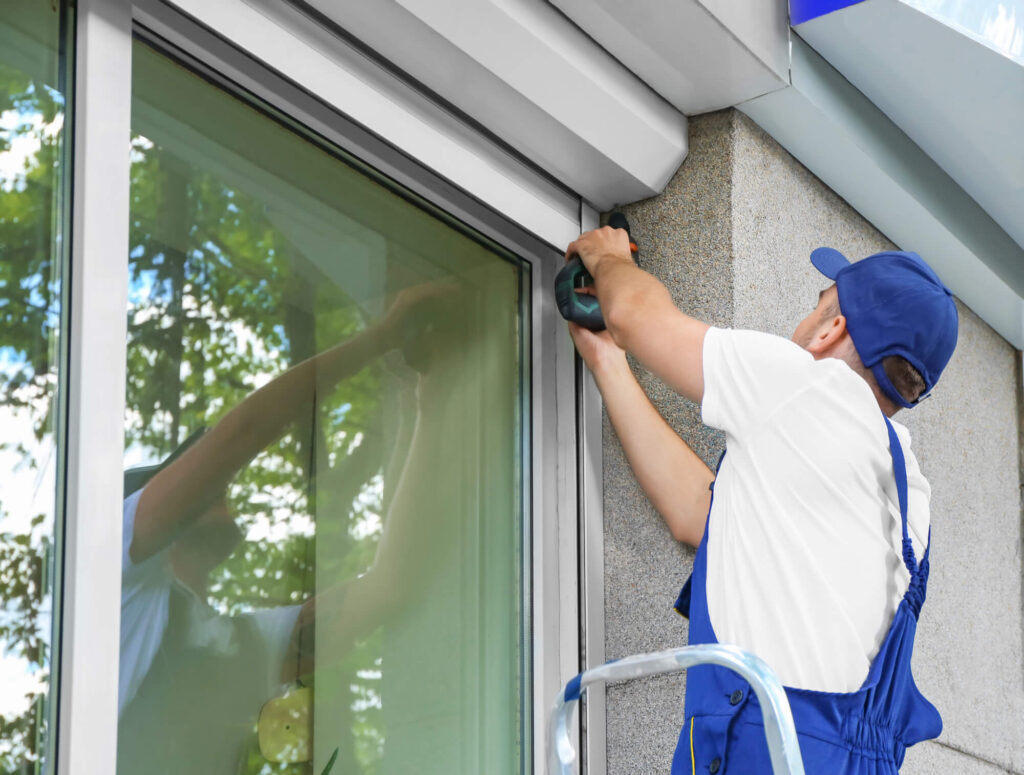
Replacing windows is one of the most impactful home improvement decisions a homeowner can make. But before diving into the project, there’s one critical question to answer: Should you attempt a DIY project or hire a professional contractor?
This blog post will walk through the pros and cons of both DIY and professional window installation. From safety risks and cost comparisons to tools, warranties, and overall performance, we’ll help you determine the best route for your home improvement goals—especially if you’re replacing an entire window or multiple windows.
Benefits of New Windows and Choosing the Right Materials
Before deciding whether to handle installation yourself or hire professionals, it’s important to understand why new windows are a valuable investment and how the right materials can improve your home.
Benefits of New Windows for Homes
- Improved energy efficiency, reducing heating and cooling costs over time.
- Better insulation and noise reduction create a more comfortable living environment.
- Enhanced curb appeal and increased home value.
- Protection against the elements, extreme weather damage, and prevention of leaks or drafts.
- Reduced risk of black mold or water damage caused by failing seals or old frames.
- Safer, updated materials that remove exposure to lead paint or asbestos.
Best Type of Materials to Consider
- Vinyl: Cost-effective, low maintenance, and great insulation properties.
- Fiberglass: Durable and resistant to warping or rotting, ideal for long-term performance.
- Wood: Classic appearance and strong insulation, though they may require more maintenance.
- Aluminum: Lightweight and affordable, but less energy efficient compared to vinyl or fiberglass.
- Composite: Blend of materials for strength, energy efficiency, and a modern look.
Pairing quality windows with energy-efficient glass and high-performance sealants will protect your home and maximize your investment—whether you choose DIY or professional installation.
The Basics of a Window Installation Process
Deciding to install new windows or do a replacement project also requires a complete understanding of the basics of what it takes (besides some hundreds of dollars). We’re talking about the prep time involved, tools, and even some one-use materials that might be a hassle if it’s a single window or DIY job.
What a Typical Installation Involves
Whether you’re doing a simple window replacement or a full-frame install, the basic steps include:
- Removing the old window and inspecting the structure for damage
- Installing or modifying the frame
- Sealing and securing the new window with caulk, sealant, and hardware
- Insulating gaps and checking the level
- Finishing with paint or putty for a seamless look
The process of expert window installation also includes code compliance checks and weatherproofing strategies, which are especially important in areas prone to extreme weather damage.
Materials and Tools Required
A successful window installation or replacement demands a well-stocked toolkit and familiarity with different materials. Here’s a sample list:
- Power drill, screwdriver, utility knife, hammer, and measurer
- One-use materials like caulk guns, sealants, putties, and weather-resistant caulks
- Pry bar, tarp, safety glasses, gloves, and a level
- Flashing tape and insulation
- Paint and touch-up supplies
Without the right tools or understanding of manufacturer instructions, complications can arise quickly in a DIY project, even with your best efforts in terms of techniques and time spent on the project.

The Case for DIY Window Installation
Without the right tools or understanding of the manufacturer’s instructions, complications can arise quickly in a DIY project, even if it comes with cost savings and a nice sense of accomplishment.
Potential Cost Savings
For many homeowners, the idea of saving money through a DIY project is appealing. Skipping labor costs can seem like a smart move for your wallet when inflation has continued to raise service prices. Plus, buying windows and materials in bulk may offer additional savings. For many people, the gamble and frustrations that might come with a DIY installation are worth it for the savings.
When DIY Might Work
DIY window replacement might be feasible for small-scale jobs or homeowners with home improvement experience. Straightforward projects with standard-size windows are more manageable, especially if you’re replacing one or two units rather than your entire house, or just minimum maintenance work, like fixing scratches, patching holes in frames, or resealing.
With determination, time, and proper study of the process, a well-prepared homeowner can complete the job using manufacturer guidelines and online tutorials. However, understanding the potential pitfalls and required tools (like a caulk gun, pry bar, level, or power drill) is essential before getting started.
Risks of DIY
There are serious risks involved in tackling a window replacement yourself:
- Poor sealing with caulk or putty can lead to air leaks and water damage.
- Unlevel installation may weaken the structure and reduce energy efficiency.
- Lack of knowledge about safety codes could result in code violations or denied insurance claims.
- Improper handling of old materials might expose you to asbestos or lead paint from walls.
- Mistakes could cost thousands of dollars in repairs later.
- Increased chances of bodily harm from tool misuse or ladder falls.
- Complications such as exposure to black mold from hidden damage.
In short, the cost savings of a DIY project may be outweighed by the risk, stress, and potential damage to your home.
The Advantages of Professional Window Installation
When it comes to window installation, hiring professionals offers a slew of advantages that can provide peace of mind and long-term benefits. From ensuring craftsmanship and compliance with safety standards to offering warranties and avoiding costly mistakes, professional installation is often a wise investment in your home’s value and efficiency.
Expertise and Experience
Hiring a professional contractor or contractor crew ensures that trained experts do your installation. Professional installation guarantees precision and speed that homeowners may lack, especially for more complex jobs.
Experts follow a proven process, from measuring and preparing the opening to weatherproofing and testing for performance. They also understand local code requirements, rules about construction disposal, and how to avoid structural issues.
Tools, Safety, and Efficiency
Professional crews come equipped with all necessary tools and safety gear. They are also trained to work efficiently with minimal disruption to your home. Unlike DIY jobs, there’s no need to spend time learning the installation process or purchasing tools like a level, screwdriver, caulk gun, or power drill.
Warranties and Quality Assurance
Many professional contractors offer both manufacturer-based warranties and contractor-based warranties. Although they can differ from company to company, overall, these warranty types protect you from issues like defective materials or faulty installation.
DIY jobs typically void manufacturer-based warranties, and mistakes made during installation won’t be covered. Professional service ensures accountability and reduces the risk of long-term problems like leaks, rot, and thermal inefficiency.

Cost Comparison: DIY vs. Professional Installation
Looking at prices isn’t enough when trying to compare the absolute, or real, cost of either DIY or professional window installations. There are hidden and long-term costs involved that shouldn’t be ignored.
Hidden Costs of DIY
While DIY may seem less expensive upfront, there are hidden costs to consider:
- Tool purchases or rentals (hammer, level, bar gun, tarp)
- Time taken away from work or personal life
- Dollars in repairs if complications arise
- No coverage for future issues without valid warranties
- Cost of code violations or penalties from improper care or disposal of waste
Value of Professional Service
Professional installation comes with a higher price tag, but it offers:
- Faster turnaround and minimal disruption
- Peace of mind through professional oversight
- Improved long-term performance and home value
- Warranties that safeguard against future problems
Factors to Consider When Deciding
When it comes to choosing between DIY and professional window installation, several crucial factors or situations should influence your decision:
Project Size
The scope of your window installation project can significantly affect your choice. For minor repairs or replacing a single window, a DIY approach could be manageable. However, if you’re planning an entire window replacement throughout your home, hiring professionals is usually the wiser option. Large-scale projects often require a level of expertise and efficiency that only seasoned contractors can provide.
Your Experience
Evaluate your own experience with home improvement projects. Have you completed similar tasks before? Understand the strengths and limitations of your handiwork. If you’ve tackled window installations in the past and are confident in your skills, a DIY project might be feasible. However, if the process is new to you, consider seeking professional help to ensure optimal results.
Tools
Window installation requires specific tools, such as glazing putty, caulking guns, shims, and spirit levels, among others. Consider whether you already own these tools or are willing to invest in acquiring them. Furthermore, ensure you know how to use them correctly to avoid costly mistakes. Lack of proper equipment and knowledge can lead to inefficient work and potential damage.
Safety
Safety is paramount when dealing with window installations. This work can involve handling glass and intricate parts, working at heights, and potential exposure to hazardous materials such as lead paint in older homes. Evaluate whether you are adequately prepared to handle these risk factors safely. Professionals are trained to manage these challenges and abide by safety regulations.
Time
Time commitment is another significant factor. Window installation is not a quick weekend project. It requires planning, precision, and patience. Ask yourself if you can dedicate the necessary time to complete the job efficiently without cutting corners or going over the timelines established. Professionals can typically complete the work faster, thanks to their expertise and experience.
Risk Tolerance
Finally, consider your risk tolerance for potential errors. DIY projects come with the risk of structural damage if not done correctly. Misalignment can cause window leaks, energy inefficiency, and long-term water damage. Additionally, there’s always the risk of personal injury. Weigh these risks against the cost savings and personal satisfaction of completing a DIY project when making your decision.
Considering these factors can help you make a more informed choice between tackling a window installation yourself or leaving it to the professionals.
Why San Antonio Homeowners Trust American Windows and Siding
American Windows and Siding offers a full-service approach to window replacement. With deep knowledge of San Antonio’s building codes and weather challenges, their team provides professional service that guarantees long-lasting results.
From choosing the right materials to expertly sealing every edge with caulk and sealant, their experts manage the entire process with skill. Homeowners benefit from contractor-based warranties and access to top-tier manufacturer partnerships, ensuring lasting protection and value.
Choose the Right Path for Your Home
While a DIY project may work for basic installs, the risks, time, and potential complications often make professional installation the better choice. Trained experts provide safety, speed, and protection through warranties, avoiding damage, code violations, and stress.
Ready to make an improvement that lasts? Contact American Windows and Siding today to get a free estimate or schedule your professional window installation and enjoy peace of mind with expert service from start to finish.









